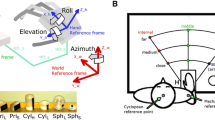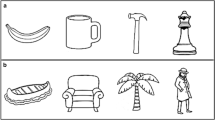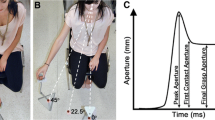Abstract
When reaching for an object, the proximity of the object, its orientation, and shape should all be correctly estimated well before the hand arrives in contact with it. We were interested in the effects of the object’s orientation on manual prehension. Subjects were asked to reach for an object at one of several possible orientations. We found that the trajectory of the hand and its rotation and opening were significantly affected by the object’s orientation within the first half of the movement. We also detected a slight delay of the wrist relative to the forearm and a small bias of the orientation of the fingers’ tips toward the orientation of the table on which the object lay. Finally, the aperture of the hand was proportional to the physical size of the object, which shows that size constancy was achieved from the variation of the object’s orientation. Taken together, these results indicate that the three components of the movement – the transport, rotation, and opening of the hand – have access to a common visual representation of the object’s orientation.
Similar content being viewed by others
Author information
Authors and Affiliations
Additional information
Received: 31 January 1996 / Accepted: 19 October 1996
Rights and permissions
About this article
Cite this article
Mamassian, P. Prehension of objects oriented in three-dimensional space. Exp Brain Res 114, 235–245 (1997). https://doi.org/10.1007/PL00005632
Issue Date:
DOI: https://doi.org/10.1007/PL00005632




